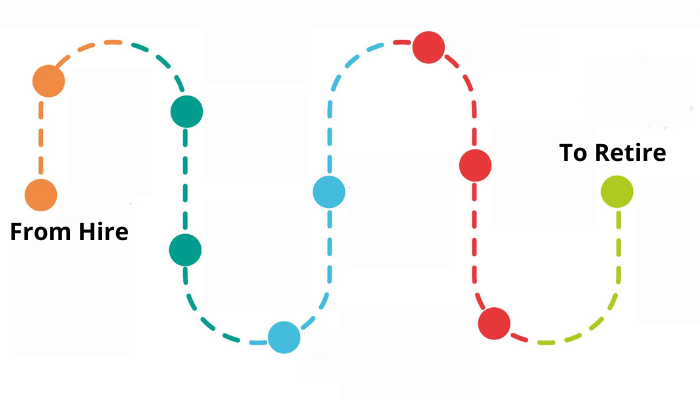The employee lifecycle comprises the different phases that an employee has to go through at an organization right from the time they can come to know about the opening to when they exit. Now the role that HR plays in the employee lifecycle management is immense. How the stages of the employee lifecycle are managed can make or break the experience that an employee has had with an organization.
The employee lifecycle model consists of several stages for an organization as well. It all begins with how it presents itself in front of a potential employee, how it communicates its own objectives and listens to the candidate’s goals, how it welcomes new people into the mix, and what it does for the personal and professional development of its employees. All of this put together allows organizations and HR managers to make the hire-to-retire journey worthwhile for their employees. By paying more attention to this aspect of workforce management, employers can enjoy several benefits, including employee satisfaction, improved productivity, and higher retention.
You might also be interested to read: Employee Onboarding – Ways to Welcome a New Employee
What is the hire-to-retire process?
Listed below are the different stages in the employee lifecycle:
- Outreach: It is very important for HRs of organizations to not only advertise job openings but also mention important details, such as organizational values, vision, mission, and goals in those job postings. This helps candidates to identify with organizations. Also, HR professionals should use different channels to make sure that their message reaches the right audience.
- Recruitment: Not so long ago, this phase in the employee lifecycle management was just about closing an opening that has been raised by a team or department in the organization. However, things have changed. HR managers are now expected to hire talent that not only comes with the desired skills but is perfectly aligned with the organization’s objectives. A candidate that fits the bill is more likely to stay with the company for a long period of time.
- On-boarding: If on-boarding is done right, it can help employees to become an integral part of the organization right from the start. It helps in allowing them to smoothly make the transition. This is a phase that the HR can use to step up their employee engagement efforts. In addition, this stage can also be used to let the new recruits know a lot more about their new employers.
- Development: This phase is all about providing training to upgrade the skills of employees. By doing this, employers make their employees ready for the new challenges that they may face in the coming time. This is another way of keeping employees engaged.
- Retention: Retaining performers is always a great challenge for employers. Competitors are always sniffing a chance to get those employees on their side. This is where HR managers have to come up with strategies that can help them keep those employees. The retention plan needs to take into consideration competitors’ policies for luring key talent.
- Off-boarding: The first thing that the employers and HR managers need to ensure is that this phase is as smooth as possible. Both the parties should separate on good terms. It is also important to ask employees about the reasons that led to their resignation. This can help employers in making sure that no employee leaves the organization because of those reasons.
A focused approach towards employee lifecycle management can help employers and HR managers to provide the best experience to employees during their term. It is very important to have the right tools in place along with a tried and tested structure to make this possible.
References:
- “Journey from hire to retire: Managing the employee life cycle” by Chandan Chattaraj on 9 March 2020
- “Employee Lifecycle: What It Is And The Stages Involved” by Mrinmoy Rabha on 21 April 2020
You might also be interested to read:
Related Topics:






